|
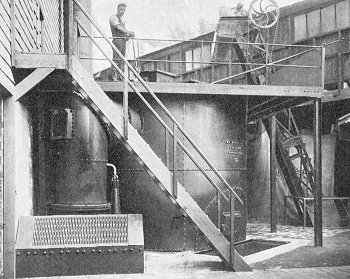
Duff's Gas Producer from 1901.
|
The Corporation decided to purchase the gas company in the mid 1860s.
Negotiations took place, but the asking price was far too high for the
Corporation and so the scheme was abandoned. In 1869 Wolverhampton
Corporation came into conflict with the gas company. Councillor R.
Sidney informed the council that he understood that the gas company was
using some of its profits to extend Stafford Road works. According to
the Act of Parliament the company could only distribute 10 percent
dividend amongst the shareholders and must have a reserve fund of £5,000.
|
| After this the balance of the profits should go
towards reducing the charges to the customers. As the
Corporation was the largest customer it was thought that it
should be charged less for gas. |
| The Corporation approached the company on this
matter and the directors challenged the Corporation to prove its
claims. The Act of Parliament under which the gas company
operated stated that any case of dispute between the company and
its customers should be referred to the Court of Quarter
Sessions at Stafford, |

Vertical sections of Duff's Gas Producer taken
at right angles to one another.
|
|

The original gas showroom in Darlington Street.
|
Their decision in the matter would be final. The case came up for
hearing and the Court ordered Mr. Carter, an accountant from Birmingham
to examine the company’s accounts. This was duly done and long arguments
were made before the Court. The verdict was that although there were
irregularities in the keeping of the accounts, the Corporation had
failed in their contention. The gas company was ordered to pay £500 for
Mr. Carter’s services and in the future income tax must be deducted from
the dividend paid to the shareholders.
|
| The company was also ordered to keep the accounts in
better form. At the next meeting of the Town Council the committee
reported that the cost of the appeal to the Quarter Sessions was £215
and the result would be a gain for the Corporation. The directors of the
gas company were very disappointed at the result. |
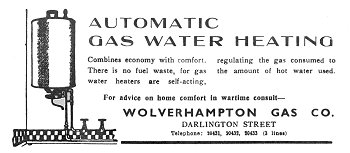
An advert from the 1940s.
|
| The chairman, Mr. Joseph Cooper, stated that during the
trial the directors had been subjected to a great deal of abuse.
In 1880 a new gas showroom was built in Darlington Street, on the
corner of Waterloo Road. It remained in use until 1938 when it was
replaced by the building that is still there today. The new showroom
opened in 1940 and was designed by local architects Lavender and
Twentyman. The building, which is known as Clock Chambers is locally
listed and today contains a shop and offices. |
|
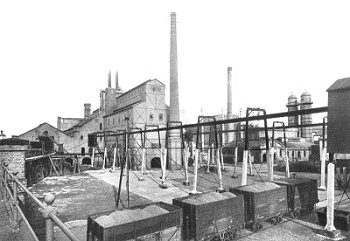
Stafford Road works in 1934. |
Stafford Road works were extended in 1900 and by 1938
the company supplied 1,250,000,000 cubic feet of gas to 46,000 clients,
which included a large number of local factories. The gasworks at
Stafford Road even had it’s own railway system and owned a number of
industrial locomotives. |
|
The showroom in Darlington Street was also the centre
of a radio network that controlled a fleet of service vans. This
enabled customers to receive service within minutes of making a
telephone call. Demonstrations of cookery, washing and refrigeration
were given by the Gas Board's Home Service Advisers and a number of
the company's engineers, who specialised in designing gas equipment
for industrial processes operated an advisory service for
manufacturers. |
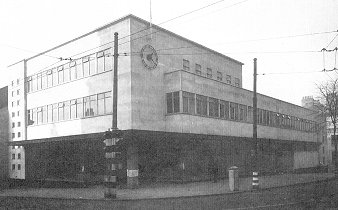
The new gas showroom in Darlington Street.
|
| Expert advice on industrial canteens and commercial
catering was also available for industrial customers. |
 |
The site of the Horseley Fields
gasworks as it is today. The works were situated behind the car park in
the photograph and the two gasometers were behind the blue car in the
centre. |
| The two large factory buildings in
the photograph are at the bottom of Union Mill Street. The one on the
left dates from 1813 and so was built before the gasworks. The one on
the right faced the gasworks. The entrance into the works from Union
Mill Street was directly in front of these two buildings, where the
small building stands on the right. One of the gasometers was
immediately behind the modern building on the right. |
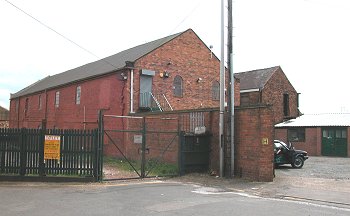 |
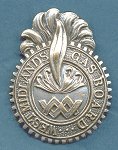 West Midlands Gas Board
lapel badge.
West Midlands Gas Board
lapel badge. |
The company survived until 1949, when it was
nationalised, along with 103 other local gas undertakings.
They were formed into 12 area Gas Boards, which took over all of
the assets of the local undertakings.
Wolverhampton Gas Company became a part of the West Midlands
Gas Board. The Gas Council acted as a liaison body between
the Area Boards and the central government. |

|
|

|
|

|
| Return to
illuminations |
|
Return to
the beginning |
|
Proceed to
bibliography |
|